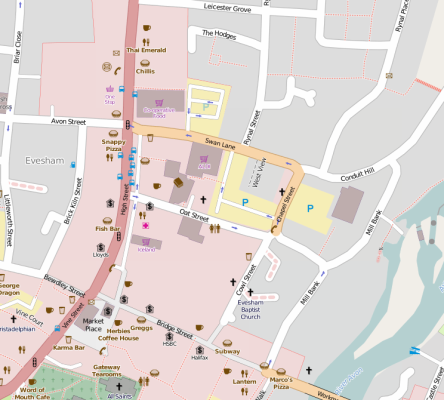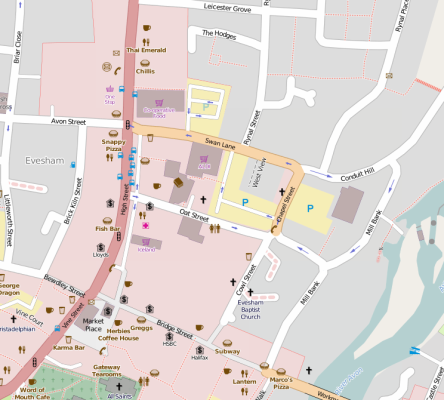Pretty much everyone who lives or works in Evesham thinks that the current traffic arrangement between the High Street and Workman Bridge, with it only being possible to travel from the bridge to the High Street and not in the other direction, is undesirable and needs to be fixed. The question is, how?
The reasons behind the current layout are many and various. Swan Lane was first made one-way as far back as 1964. Since then, it’s been two-way again, and then back to one-way, but in the opposite direction. I’m not going to go into the details of how and why it ended up the way it is now, other than to comment that it isn’t the result of some Grand Design for Evesham’s traffic, but rather a sequence of independent decisions that, individually, all make sense but, cumulatively, have had a very suboptimal outcome. Here’s what we have now:
So, what do we do? I’ve got a suggestion. Before I make it, though, I want to first take a quick look at two of the most common proposals, and explain why I don’t think they’ll fly.
Firstly, making Swan Lane, Chapel Street and Mill Street (or Mill Bank, as some maps have it) two-way all the way through. That would be the simplest solution, but it runs into several problems.
The most obvious is that if those streets weren’t considered capable of carrying two-way traffic in 1964, then they’re hardly likely to do so now. There are too many pinch points on that route for it to be suitable for two-way traffic, unless you exclude all long vehicles – but then that cuts off delivery access for Aldi, the Co-op and several other shops and businesses as well as diverting some key bus routes.
Another problem is that this would mean removing all the on-street parking on Swan Lane and Chapel Street, and this in an area where residents have little enough parking as it is. So, while superficially attractive, I really don’t think this will work.
The other commonly made suggestion is to make just Mill Street two-way, and reverse the flow in Oat Street, Swan Lane and Chapel Street. This has the advantage of avoiding almost all of the problems inherent with the first idea, but unfortunately it creates a couple of its own.
The first is that Swan Lane is currently two lanes wide for most of its length, while Oat Street just has one. What that means is that as traffic approaches the High Street along Swan Lane, it can queue at the lights in both lanes, and then when the lights go green two vehicles at a time can exit – one going left, the other going right or straight on. If you reverse the flow and send High Street bound traffic along Oat Street, then only one vehicle at a time can exit when the lights are green, meaning that the outflow capacity is halved. At peak times, that’s going to cause significant delays.
A second problem with the “reversed flow” approach is that it requires a second set of traffic lights on the High Street, just yards from an existing pedestrian crossing as well as the existing lights at the Swan Lane/Avon Street junction. That’s too many traffic lights close together, the pedestrian crossing would almost certainly have to go and it’s doubtful whether the other two sets would be far enough apart to meet DfT requirements (and, however much we may wish it were otherwise, a scheme which doesn’t meet national regulations is, and always will be, a complete non-starter).
So, given that I’ve just poured cold water on two of the most popular suggestions made by other people, what’s my idea?
My solution is simpler than the ones I’ve mentioned so far. There is, in fact, only one short stretch of road which needs to be made two-way in order to allow access from the High Street through to Workman Bridge. If you look at the map above, you can see it: the lower section of Mill Street. Make that two-way, and people can get to Workman Bridge via Oat Street, Chapel Street, Conduit Hill and Mill Bank. It’s a bit of a convoluted route, but it avoids all of the problems associated with either making Swan Lane two-way or reversing the flow in Swan Lane and Oat Street. And I think that being a bit convoluted is actually a good thing in this context, because it means that the only people who are likely to use it will be those who would genuinely benefit from it – people who are heading for Port Street and roads accessed from it, or who are heading to the Riverside Centre car park. For everyone else, it will still be quicker to go via Abbey Bridge.
That’s an important consideration, because one of the other objections to allowing traffic to reach Workman Bridge from the High Street is that Port Street is already congested and, in particular, has very poor air quality. Any changes which significantly increase traffic along Port Street, therefore, are likely to be strongly opposed. But my proposal, by making it possible, but deliberately awkward, to get to Workman Bridge from the High Street means that the traffic using it to reach Port Street will overwhelmingly be the traffic which already goes along Port Street, but at the moment reaches it from the High Street via Abbey Bridge and Waterside. There will be insufficient benefit for traffic headed elsewhere to switch to this route.
I could leave it there. But I think that it would work better with a few more tweaks.
The first is to make Conduit Hill and Mill Bank themselves one-way. This would effectively result in a figure-of-eight rotary system, with Chapel Street being the crossover. Here’s how it looks on a map:
This does still have a few potential issues, but I think they are relatively minor and can be solved. The first is that Chapel Street becomes a potential choke point. It will carry more traffic than it does now, and that will include traffic merging in from two directions at the Oat Street end. That could lead to what’s known as “weaving” problems, where cars coming from the right and wanting to turn left interlace with cars coming from the left wanting to turn right. To avoid that, it would probably be necessary to repaint the lanes at the junction with Oat Street/Cowl Street to make it clear where priority lies in the traffic flow. I’d also like to open another entrance into Oat Street car park directly from Oat Street, so that traffic heading for the car park doesn’t have to go onto Chapel Street. That will tend to offset the additional volume of through traffic on Chapel Street.
Incidentally, although it looks tight on a map, the junction between Conduit Hill and Mill Bank is not a problem. It looks awkward as it’s a greater than 90 degree turn, but the radius of the curve is easily large enough even for long vehicles. Making those streets one way also means that on-street parking can be retained, which is very much needed here and would be threatened if both streets had to continue carrying two-way traffic at greater volumes.
A second genuine issue is that the additional traffic along Oat Street will make it less attractive to pedestrians. To address that, I’d put in a “road table” – that is, a large, flat hump of the type currently used in the High Street at the Bridge Street junction – in between Wallace House and the library, to slow traffic down. If guidelines permit, making it a zebra crossing would be even more helpful.
Finally, the junction between Mill Street, Bridge Street, Monks Walk and the Workman Bridge approach may need attention. With traffic coming from the High Street wanting to then turn into Monks Walk to get to the Riverside Centre car park (or even, for delivery vans, right into Bridge Street), it may need traffic lights to keep things moving. But this would also have the benefit of also improving the exit from Monks Walk and the car park, which can be awkward at peak times. Any lights here could be synchronised with their counterparts the other side of Workman Bridge, at the Port Street/Waterside junction, so as to maximise traffic flow.
There are possibly a few other places on the route that would need some relatively minor work, such as adjusting the kerb line in a few places. And, of course, white lines would need repainting and signs installed, as well as a set of traffic lights. But, overall, I think it would be a reasonably cheap option; something else which is also very important. Whatever we do has to be doable within the county’s highways budget. And a large proportion of that budget, don’t forget, has just been spent on Abbey Bridge. There isn’t an awful lot left in the kitty, so more grandiose schemes – even if they are workable – will be very much on the back burner for quite some time.
So, that’s my suggestion. What do you think?


